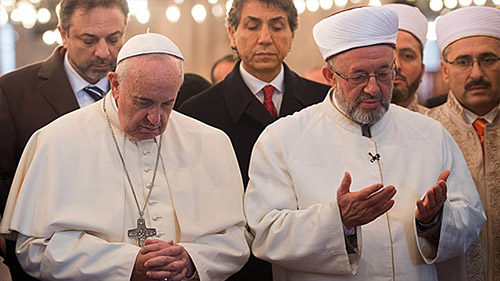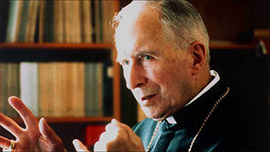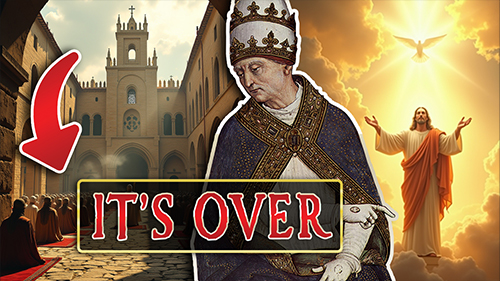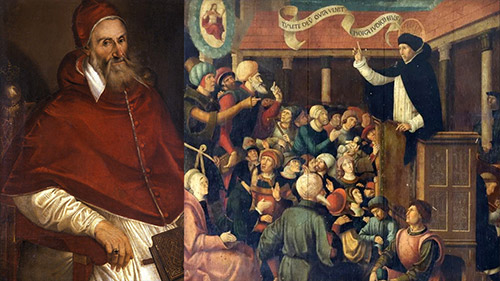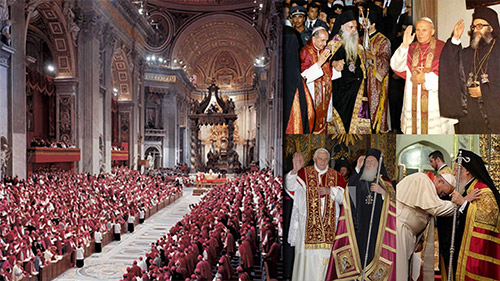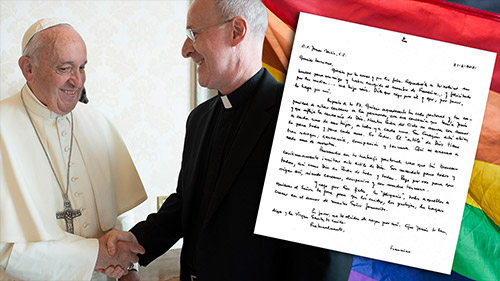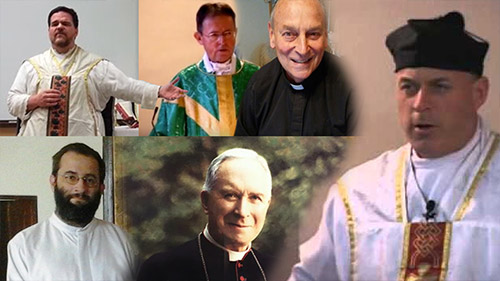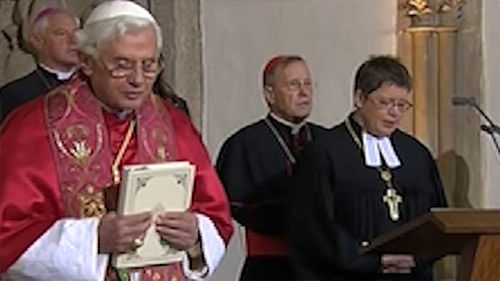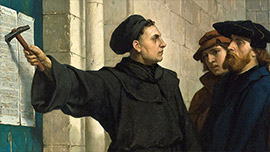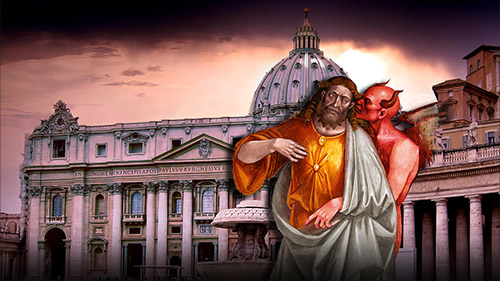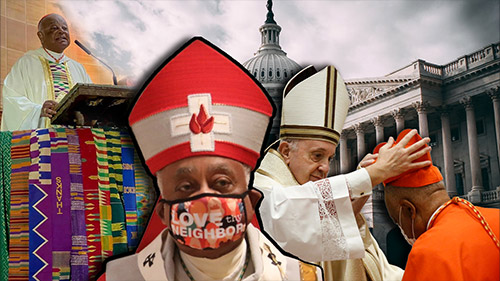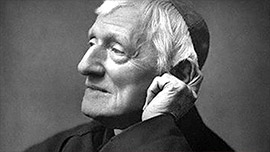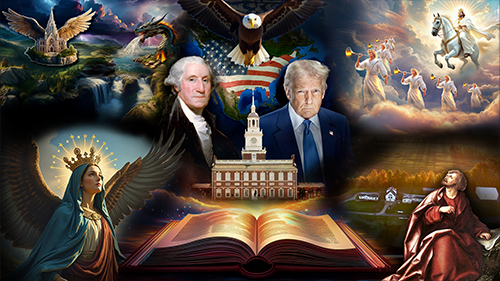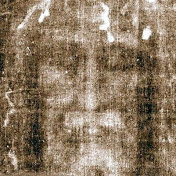 | vaticancatholic.com - English Channel |
Download Audio — File Size: 29.23 MB — Duration: 30:42 Faith & Doctrine | Featured Videos | Heresies From The Vatican II Antipopes | History | The Gates Of Hell Shall Not Prevail | Traditional Catholic Issues | Vatican II Church Is Not Catholic | Where Is The Catholic Church? Bro. Peter Dimond On Feb. 22, 1418, near the end of the Council of Constance, Pope Martin V published his bull Inter Cunctas against various errors and heresies of John Wycliffe, John Hus and Jerome of Prague. There are some extremely important statements in the bull. Some of those concern the concept of manifest heresy. They are relevant to properly understanding the current post-Vatican II crisis and why Francis is not a true pope but a heretical non-Catholic antipope. However, these passages are almost completely unknown. We will cover them in this video/article. These passages serve to further refute many false teachers in our day, such as those who wrongly claim that someone cannot be considered a manifest heretic (and therefore outside the Church) until that person is declared a heretic or openly leaves the Church by no longer claiming union with the Catholic community. That position is patently false, and we’ve refuted it before. It’s held by many anti-sedevacantists (and, as we will see in this video, it’s actually held even by some who falsely pretend to be sedevacantists). Here is the pro-Vatican II Sect heretic John Salza articulating that false position.
Question: Does Francis Profess Heresy?
As we can see, people like him hold that occult or secret heretics are members of the Church, and that even if one denies Catholic dogma publicly and repeatedly, unless that person is declared to be a heretic by a canonical judge or openly leaves the Church, he or she is still considered to be an occult heretic and therefore legally a Catholic and a member of the Church. That’s their position. It’s totally wrong and we’ve refuted it many times in the past by citing magisterial teaching that those who deny just one dogma automatically cease to be members of the Church.
The fact that they attempt to cite Cardinal Billot (a pre-Vatican II theologian) in support of their position makes no difference. The position is false and we will further refute it in this video. We will get to the key passages from Martin V’s bull, but some introductory comments are needed to understand the issues. Note: this video is not about whether occult heretics are members of the Church. Rather, it’s about how one can become a manifest heretic, because basically everyone agrees that manifest or public heretics are not members of the Church (and therefore cannot hold office in the Church). THEIR POSITION IS THAT JOE BIDEN, JAMES MARTIN, ETC. MUST BE CONSIDERED CATHOLIC AND MEMBERS OF THE CHURCH The aforementioned position, that people who publicly preach heresy and deny Catholic teaching are still occult or secret heretics (and therefore members of the Church) until they are declared heretics or openly leave the Church, is also refuted by reducing it to its absurd conclusion. For example, according to their position, radical heretics in the Vatican II Sect who notoriously depart from Catholic teaching, such as Joe Biden, James Martin, Nancy Pelosi, Walter Kasper, etc. must be considered Catholics who profess the true faith, not heretics. That’s what their principles and false premises require them to conclude. Indeed, here is the aforementioned heretic John Salza explicitly stating that he considers Joe Biden (a notorious supporter of abortion and gay ‘marriage’, among other things) to be a member of the Catholic Church, not a manifest heretic. That reveals again that the Vatican II Sect has no unity of faith, and therefore is not the Catholic Church.
That’s of course absurd and wrong, as we’ve proven many times and will further prove in this video. The same heretic (bound to his false and anti-Catholic principles) also cannot name any clerics in the Vatican II Sect – even the most radical supporters of the “LGBT” agenda – who are manifest heretics according to him.
THE CASSICIACUM THESIS Now, that preposterous and heretical position, which asserts that notorious dissenters from Catholic dogma such as Joe Biden, James Martin, Francis, etc. are Catholics and members of the Church, is not limited to defenders of Vatican II and the New Mass such as the heretic we just quoted. Guess who also holds that utterly false position on manifest heresy? It’s also held by the fake sedevacantist, Bishop Donald Sanborn and his heretical group. Yes, that’s their position. They are fake sedevacantists because even though they have claimed to be sedevacantist for years, they actually aren’t. They’ve been misleading people, and this has become clear recently as they have more fully explained their position. They hold the Cassiciacum Thesis, which is not actual sedevacantism. It’s really a form of the false recognize and resist position held by the SSPX, or one might characterize it as half way between the SSPX’s position and sedevacantism. Sanborn’s group actually makes many anti-sedevacantist arguments and attacks the true sedevacantist position (which it calls ‘totalism’). They consider ‘totalism’, that is, actual sedevacantism, to be mythology.
Sanborn’s group holds that the Vatican II antipopes have valid papal elections; that they validly appoint bishops and cardinals; that the Vatican II Sect’s ‘cardinals’ are true cardinals; that Francis is in legal possession of the office; and more.
At the same time, however, they claim that Bergogolio doesn’t have papal authority or jurisdiction, not because he’s a heretic (they actually consider him to be a Catholic, as we will see), but because he has a defect of intention.
So, as just one example of their inconsistency, they claim that you cannot recognize/judge Francis to be a public heretic, but you can (according to them) judge him not to have the requisite intention to accept the papal office (even though he claims to have accepted the papal office). It’s a false position that’s filled with errors and inconsistencies, but one of their primary errors concerns manifest heresy, which is the focus of this video/article. Like the aforementioned heretic and deceiver Salza, Sanborn’s group doesn’t understand or properly apply Catholic teaching on how heresy can be manifest by publicity of fact or notoriety of fact. As we’ve explained in various videos, people can be notorious heretics either by notoriety of law (i.e. through official warnings, a declaration, a canonical process) or by notoriety of fact (i.e. without any canonical warnings or a declaration).
That distinction is found in canon 2197 of the 1917 Code of Canon Law.
More fundamentally and importantly, the distinction is found throughout Church history and it’s rooted in dogmatic teaching and the divine law. Heretics who are notorious by notoriety of fact (who have undergone no canonical process) are sometimes called simple heretics. As Rev. Eric Mackenzie correctly noted in his pre-Vatican II work called “The Delict of Heresy”, simple heretics (i.e. people who have never been declared or even canonically warned) can be notorious heretics, even if they claim to be Catholic.
Thus, to be a notorious heretic does not require that one no longer claims to be Catholic. That fact of course contradicts heretics such as Salza, but it also contradicts people like Donald Sanborn, as we will see. While Sanborn’s group will claim to be aware of the distinction between notorious in law and notorious in fact, in essence they act as if the category notorious in fact does not exist, and they don’t properly understand or apply it. Essentially they reduce everything to what is declared by a canonical process and is therefore notorious by notoriety of law. That’s common among heretics who don’t understand what the Catholic Church is or how its unity is defined and measured. Heretics like Sanborn, Salza and others – because they don’t have the true faith – often confuse the buildings of the Church (or the purely human legal entity that controls the physical structures of the diocese) with the Church of Christ, but they are wrong. For instance, here is Donald Sanborn stating that unless someone is declared a heretic he is legally in the Church. He applies that to Francis.
According to Sanborn’s group, Francis is actually to be considered a Catholic and a member of the Church. Yes, that's their position, and if they try to deny that they are just abandoning their principles and arguments. Their position is totally false and contrary to Catholic teaching, and it would destroy the unity of the Church. In fact, here is one of their leading members, Damien Dutertre, explicitly stating that John XXIII and Paul VI were not public heretics in his view.
That’s nonsense. He doesn’t know what he’s talking about. John XXIII and Paul VI were public heretics. Paul VI, for example, publicly promoted radical false ecumenism and religious indifferentism. He also rejected proselytizing non-Catholics and much more.
People who promote such things are public heretics. We have abundant documentation on that matter. See our video called “’Saint Paul VI’s Heresies.” Indeed, as Pope Leo XIII taught:
Therefore, people who preach what Paul VI did are to be considered public heretics, not Catholics. Moreover, they say that Paul VI intended to impose a false religion upon the Church and that this is known by his public actions.
Obviously people who publicly impose a false religion are public heretics. Hence, their position is proven to be inconsistent and false. Dutertre is also totally wrong about St. Robert Bellarmine, and we can expand upon that in the future. Since Dutertre is actually embarrassed of his false position and he’s inconsistent and dishonest, he’s reluctant to apply his statement (that Paul VI and John XXIII were not public heretics) to Francis. He knows that it sounds horrible, for it’s obviously absurd to say that Francis is not a public heretic. Yet in fact he applies his false principle to Francis, just as Sanborn does, because their position is that everyone who claims to be Catholic (and has not been sentenced or declared) is legally a member of the Church. Dutertre has also articulated that false position (that all the undeclared, radical heretics in the Novus Ordo Sect must be considered Catholic) in writing. For instance, he wrote:
That’s his way of saying that they are all Catholics. He also wrote:
Again, he teaches that they are all Catholics. He applies that to all in the Vatican II Sect who claim to be Catholic and have not been declared heretics, including Francis, Biden, Pelosi, James Martin, etc. Now, we need to be clear on this point. It’s not our position that everyone who has wrongly considered the Vatican II antipopes to be true popes has become automatically (by that fact itself) a manifest heretic and part of a non-Catholic sect. That’s never been our position. Rather, we correctly hold that people become part of the Vatican II sect (and thus leave the Catholic Church into which they were baptized) when they embrace the Vatican II Sect’s heresies (such as false ecumenism) or when they manifestly adhere to the notorious heretics (such as Francis) in the face of clear evidence. Certainly, the notorious proponents of the heresies of Vatican II and false ecumenism (such as Francis) are public and manifest heretics and belong to (and lead) a non-Catholic sect. However, since Sanborn’s group doesn’t understand the unity of the Church, and they think that it’s defined by buildings – failing to realize that it’s defined by dogmatic principles – they wrongly argue that if Francis is a public heretic and the Vatican II Sect is a Counter Church, then everyone who has considered him to be the pope is part a non-Catholic sect by that very fact. No, that’s wrong. Even though it’s possible for someone to be a Catholic erring in good faith for a period of time while wrongly thinking that the Vatican II antipopes are true popes until the evidence is presented to that person, at this point almost everyone who recognizes the Vatican II antipopes is implicated in the heresies or sins of the Vatican II Sect. That’s because the heresies have been so widely taught and implemented and the Vatican II Sect has ‘canonized’ notorious heretics, false ecumenists, and idolaters such as Antipope John Paul II. That’s what the apocalyptic prophecies concerning the Whore of Babylon (a Counter Church that takes control of the Church’s physical structures in the final days) is about. Hence, Apocalypse 18:4 says:
That’s why it’s crucial to embrace the true sedevacantist position and completely reject the Vatican II Sect, which is now openly pro-‘LGBT’. In fact, in his bull Inter Cunctas (and we’re going to get to the key passages from the bull), Pope Martin V also refers to heretics who were already separated from the communion of the faithful needing to be physically expelled from God’s house.
He thus makes a distinction between people who are not part of the faithful but, for a period of time, still were in the physical structures of the Church. This is relevant to how Pope Pius X said that modernists attack the Church not from without but from within. Actual modernists are heretics who are automatically severed from the Catholic Church, but they can still attack the Catholic Church from within in a sense: i.e. if they physically operate at a Catholic building or institution. The passage from Pope St. Pius X, by the way, is another one that’s misused and misapplied by anti-sedevacantists, such as Sanborn’s group and people like Salza. The quote from Pope Martin V about the distinction between separation from the faithful and the need to be physically expelled from God’s house further refutes their misapplication. Now, here’s another member of Sanborn’s group, the heretic Nicholas Despósito, stating:
There you have it! They hold that Bergoglio is a member of the true Church. Since only those who profess the true faith can be considered members of the true Church (as Pius XII taught in Mystici Corporis), they must hold that Bergoglio professes the true faith, which is of course preposterous and blasphemous nonsense and tantamount to heresy.
‘Legally’ means “in a way that conforms to or is permitted or required by law.” Catholic law and teaching do not permit Catholics to hold that Francis – who, as they admit, publicly promotes and imposes a false religion – is Catholic. He is not legally Catholic. Legally (i.e. according to Catholic law and teaching) he's alien to the Church of Christ. The position of Sanborn's group is an affront to Catholic teaching and results in a blasphemous failure to distinguish between people who profess the true faith (legal Catholics) and public heretics who profess a false religion (aliens to the Church). Adherents of the ‘Cassiciacum Thesis’ (such as Sanborn's group) are not sedevacantists. They are just another more ‘conservative’ manifestation of the SSPX’s false ‘Recognize and Resist’ position. On many occasions they are also quite dishonest in their rhetoric (perhaps in an attempt to get supporters from sedevacantists). They frequently act as if they reject the Vatican II Sect as a false Church, and that they reject its leaders as non-Catholics, when they do not. (Their dishonesty in this regard is really tantamount to theological fraud.) In fact, they consider the Vatican II Sect (the prophesied Whore of Babylon) to be the Catholic Church, and they consider its leaders to be Catholics, as this video/article shows. By the way, Sanborn’s group teaches that souls can be saved in false religions, a blatant heresy condemned by the Catholic Church.
That heresy is directly contrary to the Church’s dogmatic teaching and the specific teaching of Popes Eugene IV, Gregory XVI, Pius IX, and others. Sanborn’s group teaches that people who are separated from Catholic unity and living in error can attain eternal life, which was specifically condemned by Pope Pius IX.
They don’t profess the true faith. Thus, it’s not a surprise that they teach an array of theological errors. In fact, here is the heretic Nicolas Despósito (who openly teaches that Protestants can be saved “outside the Church”) endorsing the position of an author who heretically taught that many pagans, Jews, and other non-Catholics can be saved without the Catholic faith. It’s blatant heresy, and it proves again that they aren’t Catholic.
That position is heretical and condemned by the Church. Years ago Donald Sanborn also told a person we knew well (named Keith) that a Jewish Rabbi who rejects Jesus would have a better shot of getting into Heaven than a Catholic who denies ‘baptism of desire’ (someone he wrongly considered to be a ‘Feeneyite’). That’s obviously evil and heretical. POPE MARTIN V REFUTES THEIR POSITION Now, let's get back to their position on manifest heresy. Just like the Vatican II and New Mass defender John Salza, we’ve shown that Sanborn’s group holds that Bergoglio/Francis and all the radical heretics in the Vatican II Sect who claim to be Catholic and have not been declared heretics are in fact to be considered Catholics. That’s their position, because they wrongly think that if you say you are Catholic you cannot become a manifest heretic until you’ve been declared or sentenced. Let’s now refute their heretical position from the teaching of Pope Martin V. In the bull Inter Cunctas, Pope Martin V makes a number of statements about people who embrace the errors of Wycliff, Hus and Jerome of Prague. Here’s the Latin text of the first passage I want to discuss.
Here’s the translation.
Here we have the pope, in an authoritative papal bull, specifically teaching that some people are public and manifest heretics (he uses the precise terms), although not yet declared by the Church (licet nondum per Ecclesiam declarati). One could hardly ask for more proof to refute heretics such as Salza, Donald Sanborn, and others on this matter. Remember, their claim is that people who teach heresy publicly are not public heretics, but only occult heretics and therefore legally Catholic and members of the Church, until they have been declared heretics by the Church or no longer claim to be Catholic. Indeed, here is Nicholas Despósito again articulating that position by stating that even if someone preaches heresy publicly, he is not a manifest heretic until he is recognized or declared by the Church.
This passage from Pope Martin V that we just quoted totally refutes them. And no, Pope Martin V is not just referring to undeclared heretics who no longer claim to be Catholics. His statement was about people who embraced, in a public way, one or more false doctrines of Wycliff, Hus or Jerome of Prague. Many of those people claimed to be Catholic and were spreading their poison in Catholic dioceses, among the faithful, in Catholic buildings, etc. In fact, here’s an interesting passage from the 1913 Catholic Encyclopedia on the followers of Hus – some of the very people Pope Martin V was referring to in his bull.
As we can see, many of the Hussites and similar heretics claimed union with the Catholic Church. But since they embraced the heretical position or positions of Wycliff, Hus or Jerome of Prague in an undeniable and public way, they were considered public or manifest heretics before any declaration was made. Moreover, in the passage quoted already Pope Martin V declared that such people were to be deprived of Christian burial, a further indication that many of them were claiming to be Catholic and part of the Catholic community while spreading their heresies. Also note that he forbids offerings to be made for such deceased individuals. This demonstrates again that Catholics are forbidden to pray for deceased heretics or deceased non-Catholics. This is contradicted by many heretics in our day. For example, here is the heretic Nicholas Despósito, contradicting Catholic teaching by teaching that it’s good to pray for everyone who died in the last ten hours.
No, Catholics are only permitted to pray for those who die as Catholics and free from obvious grave sin.
In fact, in another passage of the bull, the following things are listed as making one suspect of heresy:
In the bull, Pope Martin even prescribed the following question for certain people to be asked:
As we can see again, praying for heretics after their death was strictly forbidden. Now, after the pope refers to public and manifest heretics, although not yet declared by the Church, he states this:
Here we see that a declaratory sentence – which is a declaration that someone had already ipso facto (by the fact itself) incurred a penalty – results in additional effects, that is, the transfer of the goods of the deceased heretic to others. But the person was already treated as a heretic and deprived of Christian burial before any declaratory sentence or canonical process, based on the public fact that he was embracing heresy. This is a very important point. Declarations and canonical processes are sometimes enacted. At times they result in additional consequences. But that doesn't change the fact that various people become manifest heretics before any declaration is made. Their status as undeclared public or manifest heretics has various consequences that Catholics can and must act upon: such as by not acknowledging them as part of the faithful, depriving them of Christian burial, etc. This is also demonstrated in the paragraph just before the pope’s reference to public heretics who are not yet declared by the Church. The pope states:
In this important paragraph Pope Martin V refers to people who are public and manifest heretics by evidence of the fact. That's another acknowledgement of that whole category of individuals who are known to be public and manifest heretics without any declaration. Further, as already cited, he makes it explicit in the next paragraph that these people are undeclared. Obviously these undeclared public and manifest heretics include people who never received any canonical warning. That should be obvious. However, to preemptively refute any potential objection on this matter, we will note that it’s clear from three points. 1) The pope doesn’t mention anything about how these undeclared public and manifest heretics had been canonically warned. 2) If only canonically-warned people were to be considered public heretics, then the final warning would not differ in reality from a declaration. It would, in fact, function as a de facto declaration; and in that case the pope’s statement that these people were ‘undeclared’ would be rendered false or meaningless. 3) The Pope makes it clear that canonical judges or inquisitors were not yet involved in these cases. He instructs even those who exercise temporal jurisdiction to recognize such heretics based on their public actions and to treat them as public heretics, until they receive different instructions from canonical judges.
As we can see, the canonical judges are not yet involved. Yet, these various laypeople are told to recognize these public heretics and act upon the fact that they are public heretics. Hence, it's totally false to assert that these undeclared public heretics only refer to people who have been canonically warned. It was thus incumbent upon laypeople who did not possess ordinary ecclesiastical jurisdiction to apply Catholic principles in order to recognize manifest heretics, cast them out of Catholic places and areas and even sometimes put them into prison. But, according to the anti-sedevacantists in our day, those dukes, princes, counts, etc. should have let the heretics spread their poison and kill souls. They should have treated them as Catholics, even though they were clearly and undeniably promoting heresy, until there was a declaration by a canonical judge. But no, that’s not the Catholic way. Manifest heretics (such as Bergoglio and his fake hierarchy), who are known to be heretics by their public and undeniable departure from Catholic teaching, are to be treated as manifest heretics and not recognized as members of the Church. Pretending that they have authority or that they are in the Church, leads souls into heresy and into Hell. As St. Robert Bellarmine said:
Thus, heretical wolves are rejected as having no authority without any declaration, when it’s clear that they are publicly preaching heresy. Hence, in this video we’ve further refuted heretics such as John Salza, Donald Sanborn and others. We’ve proven that people can be manifest and public heretics without any declaration. We’ve proven that those undeclared public and manifest heretics were considered to be formal heretics by their actions. That’s why they were deprived of Christian burial. We’ve also proven that such undeclared manifest and public heretics often claimed to be Catholic. So, if someone who claims to be Catholic can and must be rejected as a manifest heretic without any declaration based on his publicly heretical positions, then of course that applies to Antipope Francis. In fact, if it doesn’t apply to Francis, then it has never applied to anyone in history. These facts just further prove that Francis is not the pope. People need to embrace the traditional Catholic faith, as our material explains. Copyright © 2023 Most Holy Family Monastery |
Bishop Sanborn And John Salza Are Totally Wrong On Manifest Heresy – New Evidence From Pope Martin V
February 20, 2023
SHOW MORE


